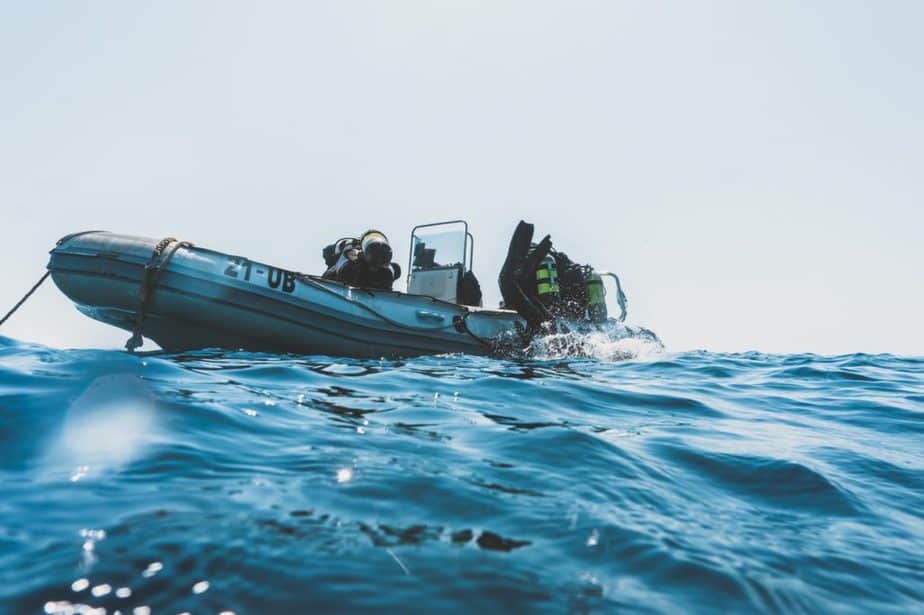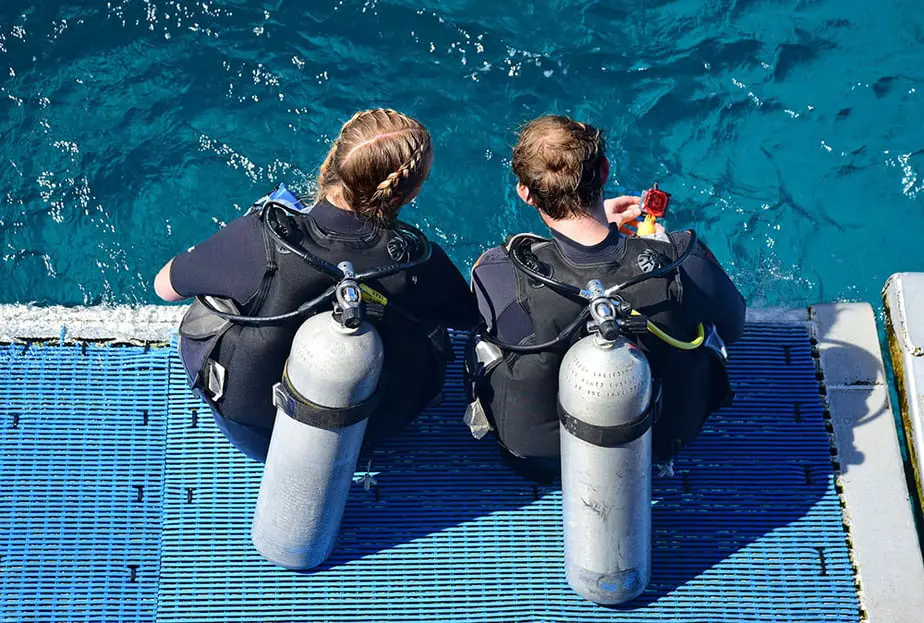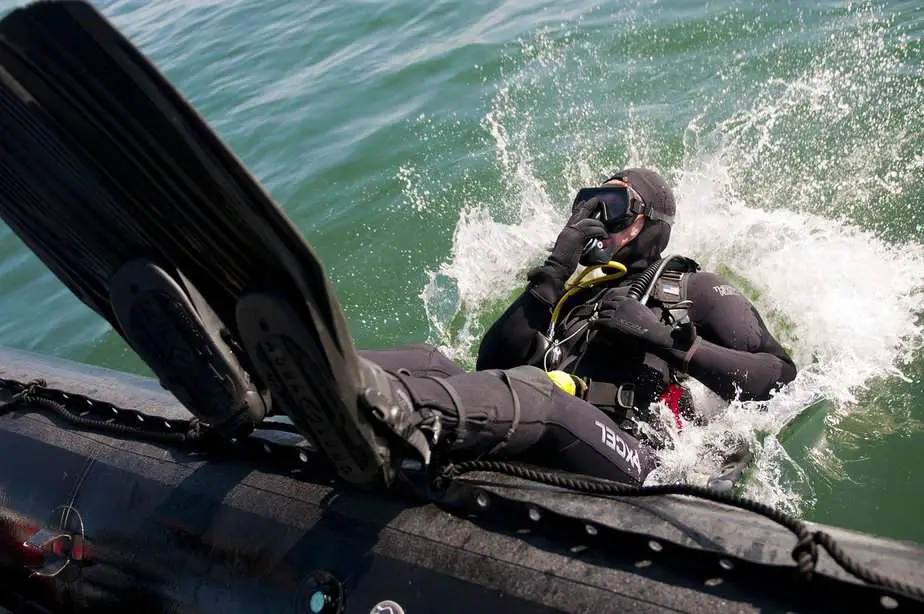If you were to jump in the water, your natural inclination is probably to dive forwards. We see swimmers do it all the time, and they use the momentum of their dive to keep up a fast pace. Yet, when it comes to scuba diving, you’ll notice scuba divers diving backwards. What benefits does diving backwards give scuba divers?
Scuba divers dive backwards to protect their body from the impact of hitting the water. They are often carrying over 40 pounds of equipment, and by diving backwards, their equipment can take the brunt of the impact for them. Furthermore, this often keeps the scuba tank and BCD from being pulled away from their body when they enter the water. Backwards entry is the ideal choice when stepping off isn’t possible.
Of course, backwards diving isn’t the only way divers can enter the water. Every scenario is different, and other types of dives can be better depending on the situation. However, the backwards dive is a tried-and-true way of entering the water safely which is why so many divers do it.
Why Enter the Water Backwards When Scuba Diving?
You might be thinking, diving backwards into the water sure doesn’t sound safe! What if I roll too far and find my legs over my head? What if I hit something behind me that I couldn’t see? And isn’t it awkward to maneuver around from a backwards position once I’m in the water?
We understand that stepping into the water seems like a more appealing idea than rolling backwards into it. However, once you understand the rationale behind it, then hopefully this will be an idea that you can get behind.
Here’s a common joke that scuba divers love to tell.
Newbie: Why do scuba divers dive backwards off the boat?
Veteran: If they dive forwards, they would still be on the boat!
Cue sensible chuckles from the rest of the crew.
In all seriousness, there are plenty of good reasons to dive backwards from a boat.
As we mentioned, the first is that diving into the water with over 40 pounds of scuba gear is tough on the body, so it’s better to let the scuba tank take the brunt of the impact. Don’t worry about damaging it, it’s a lot tougher than you are.
Another reason is that if you are diving from a small boat, then doing a backwards roll is less disruptive and keeps the boat from rocking too much. Similarly, if the boat is already unstable, a backwards dive is the safest choice because it does not require any balance.
Lastly, it’s easier to keep hold of your gear when doing a back entry. You should be using your hands to cover the hoses or any other loose equipment to ensure they don’t detach upon entry.
Back Roll Benefits
Not only is the back roll extremely safe, but it has numerous advantages that makes learning it worth your time.
It keeps the boat stable

You may be diving from a rigid inflatable boat (RIB) or other such small watercraft with questionable stability. Even if you wanted to stand fully upright for a dive, you may not be able to without drastically rocking the boat. You will notice this especially as you stand on the edge preparing to exit the gunwale, the boat will rock dramatically.
In a situation like this, for the safety of all those on the boat, a back roll is the safest option. By staying low and diving from a seated position, both you and the boat will have a lower center of gravity so neither one will lose balance.
It’s not as painful
Another benefit of the back roll is that it prevents a belly-flop scenario where you painfully slap your face and stomach against the surface of the water with 40 extra pounds adding to the force of impact. You are welcome to try one attempt doing a forwards roll, but we guarantee you won’t want to try a second time.
It’s not uncommon for water to enter the mask or for the mask to smack your face, which is why it’s so important to hold it in place with your hand. By letting the tank absorb most of the impact in a back roll, you reduce the chances of misplacing gear or filling your mask with water.
You have more control
Lastly, it is so simple to perform a back roll. It requires less movement than other types of rolls. You also don’t need to do any walking which is a relief because performing any kind of movement with all of that scuba gear is exhausting. You are free to use both hands to secure loose pieces of gear so that nothing gets loosened on impact.
How to Perform a Back Roll
Let’s go over the steps for how to safely and correctly perform a back roll. First, you should only perform the back roll at a maximum height of three to four feet from the surface of the water. Any more than that, and gravity will cause you to roll too far and you may end up landing on your head instead. If the boat is higher than this, then try a different diving method outlined in the next section.
Pre-Dive Check
No matter which diving method you are doing, you must always perform a pre-dive check. Make sure all of your equipment is in proper order. Your scuba tank should be full, the batteries on your dive computer should be full, and all of your gear fits well and are tightly secured.
You will be donning all of this gear on the boat deck to minimize walking afterwards. Once you are ready, prepare for entry by sitting on the gunwale with your back facing the water.
Secure Your Gear
Check the area behind you and make sure it’s clear. Check it again just to be safe. Now, keep one hand over your regulator while using your fingertips to press against your mask. Your free hand should be holding any loose hoses so that they don’t detach on impact. You may also use that hand to further secure your face mask, to hold the strap behind your head, or just keep it by your side.
Roll Back!
Finally, tuck your chin downwards and lean back over the edge of the boat. Gravity should take care of the rest. Straighten your legs as you lean back so that they don’t hit the side of the boat. Once you’ve made impact, take a few seconds to get your bearings. Signal to the crew on the boat that you’ve entered the water safely. That’s all there is to a back roll. This simple dive is an effective and safe way to enter the water.
When You Shouldn’t Do a Back Roll
You should know when it is appropriate to perform a back roll. You may not always be diving under the same circumstances, so there will be times when another entry method is safer.
If you are not a fan of the back roll, you may be pleased to hear that there are times when you shouldn’t do a back roll entry. You must ask yourself the following questions to determine if a back roll is the right choice.
First, how deep is the water? A back roll should only be performed in deep, clear water. If it is too shallow, you may make contact with the bottom. You should only dive in clear water so you can see what’s awaiting you beneath the water.
Second, how far from the surface of the water are you? We mentioned that you should perform a dive roll at a maximum height of 3-4 feet. Too high of a distance, and you may roll too far and land on your head. You may also hit the side of the boat, causing injury to your body or damage to your gear.
Lastly, is the platform/boat stable? If so, then it may be safe enough for you to perform a different kind of entry if you aren’t a fan of diving backwards. We will cover two additional entry methods below.
Alternative Entry Methods
As we mentioned, a back roll is not the only scuba diving entry method. In fact, if you are diving from a height greater than 4 feet, then you should be diving a different way. Here, we discuss two alternative entry methods: the giant stride and the seated entry.
The Seated Entry

The seated entry is yet another straightforward method similar to a back roll. It is best performed when the water is too shallow or if you aren’t on a steady platform. This is the ideal entry method for elderly divers.
You require a platform or gunwale that is very close to the water. Don all of your dive gear and then set with your legs dangling over the water. Do a final check for any debris or obstacles below you. Check that your gear is working properly. When you are ready to dive, keep one hand on your mask, and use the other to gently push yourself away from the platform and into the water.
The Giant Stride
As the name suggests, the giant stride requires you to take a large enough step off the boat so that your tank and other scuba gear don’t scrape the side of the boat as you fall down. Hold on tight to your mask and regulator so that they don’t get blown off on entry. It’s really simple, just like the back roll. Don’t try to jump; it’s just a waste of energy because you are carrying extra weight on you. You will be entering the water feet first compared to the back roll.
The giant stride entry method is best done from a stable platform such as a pier, dive boat, edge of the pool, and into deep water. Remember to don all of your gear by the edge of the platform so that you don’t have to walk very far to dive. The ready position should be at the edge of the platform with your fins hanging halfway over.
Some experts recommend inflating your BCD halfway so that you do not immediately sink into the depths when you hit the water.
Summary
In this article, we discussed why scuba divers dive backwards into the water. This maneuver is known as the back roll, and the main reasons for doing it are that it’s safe, stable, and easy to do. A back roll should only be done into deep and clear water, from a maximum height of 3-4 feet.
Two other popular entry methods are the giant stride entry and seated entry. The giant stride should be performed in situations where the back roll shouldn’t, i.e. from a height greater than 3-4 feet. You may also decide to do it if the boat is stable enough to allow you to do it. The seated entry is a gentle way of entering shallow water. It is the optimal entry method for the elderly.
No matter how you dive, you should always keep one hand on the regulator and mask to keep it secure. The other hand can be used to hold loose hoses or the strap behind the mask. Once you enter the water, signal to the boat on the crew that you are okay before continuing your dive. By following the tips outlined in this article, you should be able to safely dive backwards into the water like a pro.
If you’d like to learn more scuba beginner tips, then check out this article.


